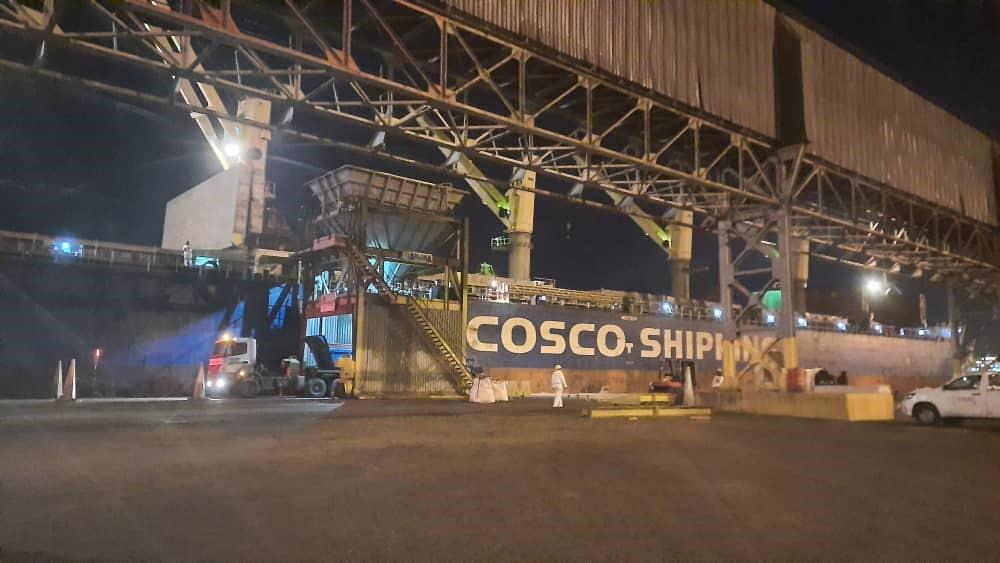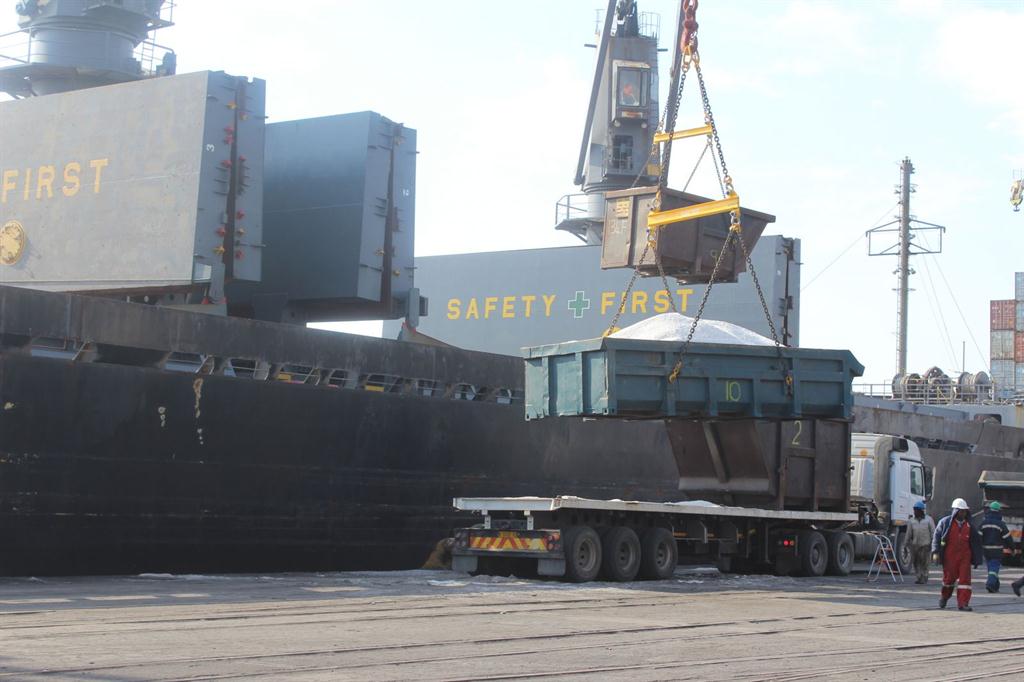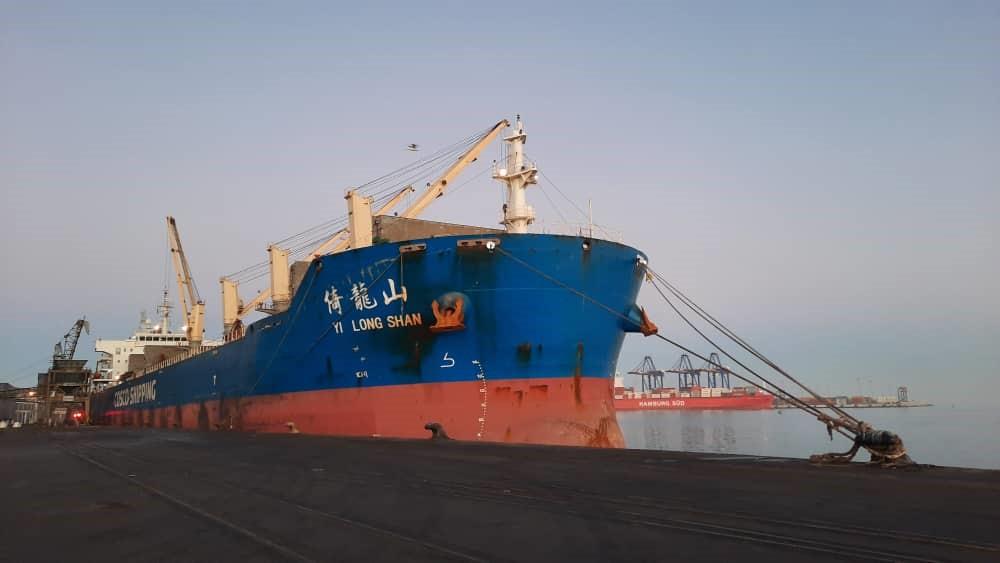Mine freight flows through Namport
Walvis Bay and Lüderitz port volumes keep growing as Namibia becomes logistics hub
Augetto Graig
WINDHOEK
The Namibian harbour authority Namport keeps reaching new heights and setting new records as it leads the country on a national drive to be the preferred southern African logistics hub, particularly for bulk freight.
The flagship port of Walvis Bay added to its ever-growing list of achievements on Friday, 3 July, when the cargo-carrying giant Yi Long Shan docked on her maiden visit from the port of Denmark.
The vessel offloaded a record-breaking 42 000 tons of sulphur destined for Namibia’s Husab mine, where Swakop Uranium uses it in its recovery process.
According to acting commercial executive Elisa Hasheela, “Namport’s unrivalled, skilled and experience workforce worked hard during the operation while providing unmatched customer experience during her time spent alongside berth number three”.
The Ui Long Shan departed from Walvis Bay harbour on 16 July.
According to Hasheela, the largest previous consigment of sulphur at Walvis Bay was 30 000 tons, but Namport has long grown the harbour’s capacity, as well as that of the southern Lüderitz harbour, to facilitate mining bulk transportation needs.
Cargo handled during this last financial year 2019/2020 was again on the increase with the largest portion of growth reflected by the increased activity along the Trans-Oranje Corridor, with 207 620 tonnes of manganese ore exported via the port of Lüderitz.
Cargo volumes up
The first of these consignments was received through the port of Lüderitz last September, and continuation of this arrangement will further contribute to Namport recording a total of 360 000 tonnes of cargo per annum through the port of Lüderitz, resulting in a predicted 60% overall volume increase for Namibia’s second port.
This increase will double the annual throughput for this commodity to 720 000 tonnes.
In June, one of the largest vessels to ever dock in Namibian waters, the CMA CGM operated MV Mediterranean Bridge, with a length of 335.63 metres, called at the port of Walvis Bay.
Following the successful trial call of the first 9 000 twenty-foot equivalent units (TEUs) Maersk Sheerness with the length of 335 meters on 24 April, the Mediterranean Bridge commenced discharging 1 781 TEUs and loading 697 TEUs on 23 June, amounting to a record of 2 478 TEUs handled for a single vessel at the port of Walvis Bay.
The vessel departed on 25 June at 11:07, almost an hour before its scheduled departure time of 12h00.
Servicing more, larger vessels
“The completion and commissioning of the new container terminal at Namibia’s gateway (port) for international trade to and from the Southern African Development Community region gives impetus on the port’s ability to service more and larger international vessels, and the Yi Long Shan vessel is a magnificent testimony to the importance of the Namibia-Europe trade corridor,” Hasheela said.
The new container terminal has a capacity of at least 750 000 TEUs per annum and was commissioned on 24 August 2019. From Walvis Bay, Namibia connects to ocean trade corridors with Europe, the United States of America and Canada, South America, the Middle East and the Fast East, while road networks coordinated by the Walvis Bay Corridor Group allow smooth connectivity into the rest of Africa.
Namport reported that in the past financial year 2019/2020 ending 31 March 2020, imports such as steel, sulphur and ammonium nitrate performed well in comparison to the previous financial year 2018/2019.
The total cargo handled was over a million tonnes, up 30% from the previous financial year. The increased demand for marble exports to international markets led to a 26% increase in volumes compared to the previous financial year. Meanwhile, sulphur imports increased by 10%. In addition, the local demand for ammonium nitrate also increased by 150%.
Volumes increase
Volumes recorded in the financial year ending 31 March show cargo along the Walvis Bay-Ndola-Lubumbashi Development Corridor up by 4% from 718 086 tonnes (2018/2019) to 743 646 tonnes (2019/2020). Namport is currently in discussions with the Oldendorff Shipping Line to have its own barge option.
A barge is a long flat-bottomed boat for carrying freight, either under its own power or towed by another.
“These results we have managed to attain as an entity are due to the efficient and improved turnaround times at Namibian border posts, security in transport corridors, efficacy at both ports, the strong relationships Namport has managed to foster with customers from the Democratic Republic of Congo, Zambia and South Africa, the dedication and unwavering commitment of the Namport staff members to rendering world class service to their clients as well as the company’s constant presence in these markets,” Namport spokeswoman Taná Pesat said.
“More than ever before, the Namibian Ports Authority remains committed to making Namport the port of choice for the international market.”
Fuel flows
In July, Namport and Engen Namibia also announced that Engen acquired the exclusive services of a 2000 MT Barge, which will be made available to rigs, support services and offshore passing vessels lying at anchorage, for the bunkering of Gasoil (10 PPM and 500 PPM) at the ports of Walvis Bay and Lüderitz.
Engen Namibia managing director Christian Li said the company is a firm supporter of Namport’s vision to attract increased cargo to the port of Walvis Bay and position the Walvis Bay Corridor as a natural gateway for international trade by offering direct access to principal shipping routes.
In its annual report for 2018/2019, Namport said petroleum made up 34% of the total bulk and break-bulk import volumes, increasing by 10% from the previous financial year due to high demand from uranium mines.
Demand for copper concentrates from local processing plants increased significantly by 108% year-on-year, on the back of high demand from the Far East, while the oil rig, then at anchorage at the port of Walvis Bay since May 2018, conducted maintenance work in preparation of its next assignment.
This led to an increase in ship spares imported, in comparison to previous year’s average commodity figures.
Imports and exports
The import of manganese ore, which is used in the extraction of uranium ore at local mines, also increased significantly at 92% year-on-year in 2018/2019.
Bulk and break-bulk exports increased by 206 114 tonnes during the 2018/2019 reporting year, representing an increase of 24%.
Salt exports constituted 40% of the total cargo exported through Namport’s ports thanks to an increase in demand for local salt in overseas markets.
The increase in lithium ore exports was the result of the first export consignment destined for Asia through the port of Walvis Bay.
However, unfavourable exchange rates impacted the exports of marble into international markets, leading to a 16% decline in 2018/2019 compared with the previous reporting year.
Since then, the Desert Lion Lithium Project near Karibib has stopped shipping lithium due to a drop in the global market price for lithium carbonate, although after Australia’s Lepidico took over in May, it was able to raise A$3.86 million (N$45.38 million) for further development of the world class deposit there.
Corona impact
Namport’s latest achievements come amidst a deadly outbreak of Covid-19 in Namibia, followed by the declaration of a national state of emergency and the repeated imposition of a lockdown on Walvis Bay.
The port authority took prompt action after the outbreak was reported early in March, and has instituted strict and comprehensive health directives. Continuous risk assessment and consistant application of level one lockdown measures have been the order of the day.
Personnel who test positive for Covid-19 are quickly placed under quarantine and contacts are traced while revelant work areas are subjected to continuous disinfecting.
In June, Namport acting CEO Kavin Harry acknowledged productivity is impacted by the health measures, which include office-based staff working from home, reduced deployment of resources and the suspension of berthing window arrangements.
Although now on a first come, first served basis, unless critical or essential goods are prioritised, all contrainer terminal berths remain operational.
Bulk and break-bulk quayside terminal operations are limited to three working vessels, while manpower deployed to the Syncrolift has been reduced by half.
Furthermore, truck entry permits are now issued at the security office while temperature screening and hand sanitiser use is compulsory.
[email protected]
WINDHOEK
The Namibian harbour authority Namport keeps reaching new heights and setting new records as it leads the country on a national drive to be the preferred southern African logistics hub, particularly for bulk freight.
The flagship port of Walvis Bay added to its ever-growing list of achievements on Friday, 3 July, when the cargo-carrying giant Yi Long Shan docked on her maiden visit from the port of Denmark.
The vessel offloaded a record-breaking 42 000 tons of sulphur destined for Namibia’s Husab mine, where Swakop Uranium uses it in its recovery process.
According to acting commercial executive Elisa Hasheela, “Namport’s unrivalled, skilled and experience workforce worked hard during the operation while providing unmatched customer experience during her time spent alongside berth number three”.
The Ui Long Shan departed from Walvis Bay harbour on 16 July.
According to Hasheela, the largest previous consigment of sulphur at Walvis Bay was 30 000 tons, but Namport has long grown the harbour’s capacity, as well as that of the southern Lüderitz harbour, to facilitate mining bulk transportation needs.
Cargo handled during this last financial year 2019/2020 was again on the increase with the largest portion of growth reflected by the increased activity along the Trans-Oranje Corridor, with 207 620 tonnes of manganese ore exported via the port of Lüderitz.
Cargo volumes up
The first of these consignments was received through the port of Lüderitz last September, and continuation of this arrangement will further contribute to Namport recording a total of 360 000 tonnes of cargo per annum through the port of Lüderitz, resulting in a predicted 60% overall volume increase for Namibia’s second port.
This increase will double the annual throughput for this commodity to 720 000 tonnes.
In June, one of the largest vessels to ever dock in Namibian waters, the CMA CGM operated MV Mediterranean Bridge, with a length of 335.63 metres, called at the port of Walvis Bay.
Following the successful trial call of the first 9 000 twenty-foot equivalent units (TEUs) Maersk Sheerness with the length of 335 meters on 24 April, the Mediterranean Bridge commenced discharging 1 781 TEUs and loading 697 TEUs on 23 June, amounting to a record of 2 478 TEUs handled for a single vessel at the port of Walvis Bay.
The vessel departed on 25 June at 11:07, almost an hour before its scheduled departure time of 12h00.
Servicing more, larger vessels
“The completion and commissioning of the new container terminal at Namibia’s gateway (port) for international trade to and from the Southern African Development Community region gives impetus on the port’s ability to service more and larger international vessels, and the Yi Long Shan vessel is a magnificent testimony to the importance of the Namibia-Europe trade corridor,” Hasheela said.
The new container terminal has a capacity of at least 750 000 TEUs per annum and was commissioned on 24 August 2019. From Walvis Bay, Namibia connects to ocean trade corridors with Europe, the United States of America and Canada, South America, the Middle East and the Fast East, while road networks coordinated by the Walvis Bay Corridor Group allow smooth connectivity into the rest of Africa.
Namport reported that in the past financial year 2019/2020 ending 31 March 2020, imports such as steel, sulphur and ammonium nitrate performed well in comparison to the previous financial year 2018/2019.
The total cargo handled was over a million tonnes, up 30% from the previous financial year. The increased demand for marble exports to international markets led to a 26% increase in volumes compared to the previous financial year. Meanwhile, sulphur imports increased by 10%. In addition, the local demand for ammonium nitrate also increased by 150%.
Volumes increase
Volumes recorded in the financial year ending 31 March show cargo along the Walvis Bay-Ndola-Lubumbashi Development Corridor up by 4% from 718 086 tonnes (2018/2019) to 743 646 tonnes (2019/2020). Namport is currently in discussions with the Oldendorff Shipping Line to have its own barge option.
A barge is a long flat-bottomed boat for carrying freight, either under its own power or towed by another.
“These results we have managed to attain as an entity are due to the efficient and improved turnaround times at Namibian border posts, security in transport corridors, efficacy at both ports, the strong relationships Namport has managed to foster with customers from the Democratic Republic of Congo, Zambia and South Africa, the dedication and unwavering commitment of the Namport staff members to rendering world class service to their clients as well as the company’s constant presence in these markets,” Namport spokeswoman Taná Pesat said.
“More than ever before, the Namibian Ports Authority remains committed to making Namport the port of choice for the international market.”
Fuel flows
In July, Namport and Engen Namibia also announced that Engen acquired the exclusive services of a 2000 MT Barge, which will be made available to rigs, support services and offshore passing vessels lying at anchorage, for the bunkering of Gasoil (10 PPM and 500 PPM) at the ports of Walvis Bay and Lüderitz.
Engen Namibia managing director Christian Li said the company is a firm supporter of Namport’s vision to attract increased cargo to the port of Walvis Bay and position the Walvis Bay Corridor as a natural gateway for international trade by offering direct access to principal shipping routes.
In its annual report for 2018/2019, Namport said petroleum made up 34% of the total bulk and break-bulk import volumes, increasing by 10% from the previous financial year due to high demand from uranium mines.
Demand for copper concentrates from local processing plants increased significantly by 108% year-on-year, on the back of high demand from the Far East, while the oil rig, then at anchorage at the port of Walvis Bay since May 2018, conducted maintenance work in preparation of its next assignment.
This led to an increase in ship spares imported, in comparison to previous year’s average commodity figures.
Imports and exports
The import of manganese ore, which is used in the extraction of uranium ore at local mines, also increased significantly at 92% year-on-year in 2018/2019.
Bulk and break-bulk exports increased by 206 114 tonnes during the 2018/2019 reporting year, representing an increase of 24%.
Salt exports constituted 40% of the total cargo exported through Namport’s ports thanks to an increase in demand for local salt in overseas markets.
The increase in lithium ore exports was the result of the first export consignment destined for Asia through the port of Walvis Bay.
However, unfavourable exchange rates impacted the exports of marble into international markets, leading to a 16% decline in 2018/2019 compared with the previous reporting year.
Since then, the Desert Lion Lithium Project near Karibib has stopped shipping lithium due to a drop in the global market price for lithium carbonate, although after Australia’s Lepidico took over in May, it was able to raise A$3.86 million (N$45.38 million) for further development of the world class deposit there.
Corona impact
Namport’s latest achievements come amidst a deadly outbreak of Covid-19 in Namibia, followed by the declaration of a national state of emergency and the repeated imposition of a lockdown on Walvis Bay.
The port authority took prompt action after the outbreak was reported early in March, and has instituted strict and comprehensive health directives. Continuous risk assessment and consistant application of level one lockdown measures have been the order of the day.
Personnel who test positive for Covid-19 are quickly placed under quarantine and contacts are traced while revelant work areas are subjected to continuous disinfecting.
In June, Namport acting CEO Kavin Harry acknowledged productivity is impacted by the health measures, which include office-based staff working from home, reduced deployment of resources and the suspension of berthing window arrangements.
Although now on a first come, first served basis, unless critical or essential goods are prioritised, all contrainer terminal berths remain operational.
Bulk and break-bulk quayside terminal operations are limited to three working vessels, while manpower deployed to the Syncrolift has been reduced by half.
Furthermore, truck entry permits are now issued at the security office while temperature screening and hand sanitiser use is compulsory.
[email protected]





Kommentar
Allgemeine Zeitung
Zu diesem Artikel wurden keine Kommentare hinterlassen